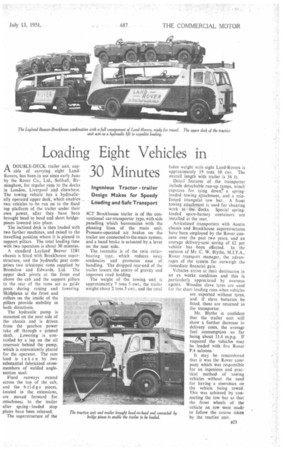Loading Eight Vehicles in 30 Minutes
Page 57

If you've noticed an error in this article please click here to report it so we can fix it.
Ingenious Tractor. trailer Design Makes for Speedy Loading and Safe Transport
ADOUBLE-DECK trailer unit, capable of carrying eight LandRovers. has been-in use since early June by the Rover Co., Ltd., Solihull, Birmingham, for regular runs to the docks in London, Liverpool and elsewhere. The towing vehicle has a hydraulically operated upper deck, which enables two vehicles to be run on to the fixed top platform of the trailer under their own power, after they have been brought head to head and short bridgepieces lowered into place.
The inclined deck is then loaded with two further machines, and raised to the travelling position where it is pinned to support pillars, The total loading time with two operators is about 30 minutes.
A standard Leyland Beaver 1281 chassis is fitted with Brockhouse superstructure, and the hydraulic gear comprises two telescopic rams supplied by Bromilow and Edwards, Ltd. The upper deck pivots at the front end above the cab and the support pillars to the rear of the rams act as guide posts during raising and lowering. Skidplates at the front and rollers on the inside of the pillars provide stability in both directions.
The hydraulic pump is mounted on the near side of the chassis and is driven from the gearbox power take off through a jointed shaft. Lowering is controlled by a tap on the oil reservoir behind the pump. which is conveniently placed for the operator. The ram load is taken by two substantial fabricated crossmembers of welded anglesection steel.
Fixed runways extend across the top of the cab, and the bridge pieces, located in the extensions, are moved forward for attachment to the trailer after spring loaded stop plates have been released.
The superstructure of the
4CT Brockhouse trailer is of the conventional car-transporter type, with side panelling which harmonizes with the pleasing lines of the main unit. Pressure-operated air brakes on the trailer are connected to the main system, and a hand brake is actuated by a lever on the near side.
The turntable is of the twin rollerbearing type, which reduces sway tendencies and promotes ease of handling. The dropped rear-end of the trailer lowers the centre of gravity and improves road holding.
The weight of the towing unit is approximately 7 tons 5 cwt., the trailer weighs about 2 tons 5 cwt., and the total laden weight with eight Land-Rovers is approximately 19 tons 10 cwt. The overall length with trailer is 56 ft.
Detail features of the transporter include detachable run-up ramps, winch capstans for tying down, a springloaded towing attachment, and a reinforced triangular tow bar. A front towing attachment is used for shunting work at the, 'docks. Special springloaded spare-battery containers are installed at the rear.
Articulated transporters with Austin chassis and Brockhouse superstructures have been employed by the Rover concern over the past two years. and an average delivery-cost saving of £2 per vehicle has been effected. ln the opinion of Mr. C. W. Biythe, M.1.T.A., Rover transport manager, the advantages of the system far outweigh the immediate financial gain.
Vehicles arrive at their destination in an ex works condition and this is particularly appreciated by overseas agents. Wooden slave tyres are used for the short loading runs when vehicles are exported without tyres, and if slave batteries be fitted, these are returned in the transporter.
Mr. Blythe is confident that the trailer unit will show a further decrease in delivery costs, the average fuel consumption so far being about 11.4 m.p.g. If required the vehicles may be loaded with five Rover P.4 saloons.
It may be remembered that it was the Rover come pany which was responsible for an ingenious and practical method of towing vehicles without the need for having a steersman on the vehicle being towed. This was achieved by connecting the tow bar so that the front wheels of the vehicle on tow were made to follow the course taken by the tractive unit.




























































































